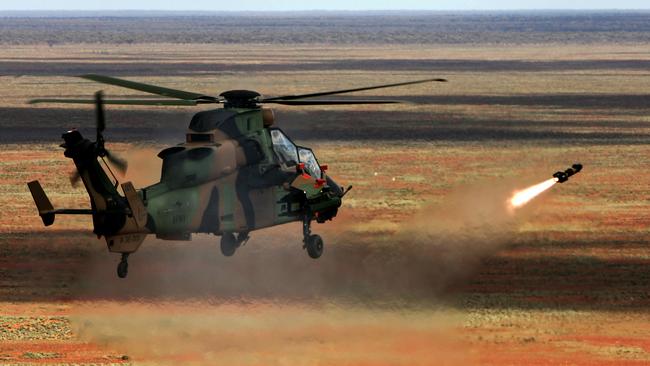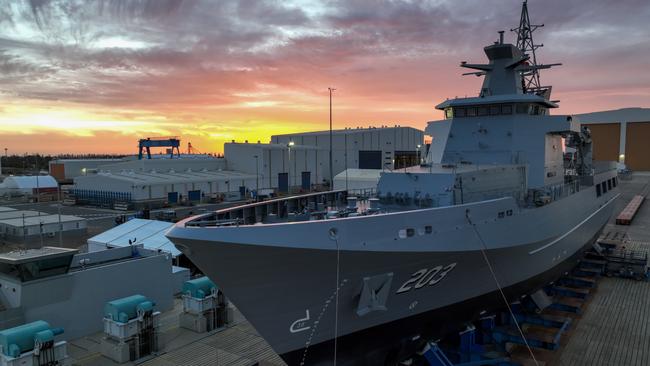Multi-billion dollar spend on Australia’s defence capability amid rising global tensions
As global and regional tensions simmer on a tightrope, Australia is splashing billions on an arsenal of ships, planes, tanks and weapons to shore up our security. Find out what’s in the pipeline.
SA News
Don't miss out on the headlines from SA News. Followed categories will be added to My News.
Australia is racing to close significant gaps in military preparedness, Defence Minister Richard Marles says, by spending billions of dollars to “bring capability to bear as quickly as we possibly can”.
The nation no longer has the luxury of a ten-year warning time for conflict, he said, and cannot wait for nuclear-powered submarines to roll off Adelaide production lines in the early 2040s.
Defending Australia is now a “far more challenging task”, Foreign Affairs Minister Penny Wong said, and “the risk of an accident and potential escalation” is growing from large-scale Chinese military operations in the Taiwan Strait and “unsafe, unprofessional and unacceptable incidents” by its navy.
Australia is responding with a multi-billion dollar arsenal of new capability, including six anti-submarine Hunter Class frigates and 11 general purpose frigates, tripling the navy’s total vertical launch missile capability to more than 700 cells.
The Army will get 42 high-mobility artillery rocket systems, equipped with precision strike missiles and guided multiple launch rocket systems with ranges beyond 500km.
The RAAF will get longer range missiles and will continue work on developing hypersonic air-launched weapons to be deployed on Super Hornet fighter aircraft.
Mr Marles said buying the 11 general purpose frigates, as part of a “blueprint for a larger and more lethal” navy fleet announced in late February, would be “the speediest acquisition of a major surface combatant that we’ve seen in recent times”.
“You inherit the world as you find it and you make the best decisions you can given that. We’re definitely in a race … because we need to bring capability to bear as quickly as we possibly can,” he said.


This capability race spurred the decision to acquire Virginia-class nuclear-powered submarines from the United States, Mr Marles said, so that these long-range boats could be in the water by the early 2030s ahead of Adelaide-built AUKUS submarines in the early 2040s.
“So you can see a whole lot of decisions that we’ve taken, which speaks to the race that we are in. We need to be closing those capability gaps and we need to be getting capability in place as quickly as we can,” he said.
Opposition Leader Peter Dutton used his Budget reply speech to condemn Labor’s defence priorities, declaring the Coalition would “reprioritise Canberra-centric funding and make an additional investment in Defence to rapidly enhance the capability of our men and women in uniform”.


“We’re working with leaders in defence industry to identify projects and investments that can be made in Australia to keep us safe in an uncertain world,” Mr Dutton said.
But Mr Marles said he was confident of winning the race to close the capability gaps, for which successive Labor and Coalition governments have been blamed.
“I feel we can do this. We’ve got agency here and we’re prepared to make the difficult decisions, which this government is making, and to make sure we’re properly funding them, which again, this government is doing, then I actually think that we can get there and I’m confident that we will,” he said.
South Australian Premier Peter Malinauskas, who will be a keynote speaker at the Defending Australia summit just after returning from an AUKUS-focused United States visit, said he did not believe the scale of the opportunity and task to build nuclear-powered submarines had sunk in on Australia’s eastern seaboard.
“The size of the challenge before us as a country to build nuclear submarines in the timelines that have been outlined is so big that it requires an all-hands-on-deck approach,” Mr Malinauskas said.
“The industry uplift required to achieve this cannot be done in South Australia alone. Whether they’re engineering firms, design firms, training providers – these types of businesses around the country will have to participate in the national endeavour of nuclear submarine building, and the time to act is now.”


The Asia Pacific government solutions vice president of global defence and aerospace firm KBR, Nic Maan, said the drive to deliver technology quickly and efficiently would interest young people and urged efforts to entice school students into defence careers.
“Rather than try and capture them through the university cycle, get kids interested, even in early high school, in STEM and so on more,” he said.
“That’s some of the investments we have to make and we have to make their career interesting. We have to give them an excitement around the technologies that they’ll be involved in.”
Mr Maan, whose firm includes the nuclear expertise of Frazer Nash Consultancy, said there was a perception that the nuclear-powered submarine pillar of the AUKUS pact was going slowly.
“But when you think of he complexity and the national endeavour that we’re talking about here, I think it’s going as well as, from my external observation, it’s going as well as anyone could hope for,” he said.
The second pillar of AUKUS, focused on technology exchange and transfer, offered significant opportunity for rapid developments.
“I think pillar two definitely offers some opportunity for more short-term capability delivery and I think we already see, through the news and through the public domain, that that’s occurring, which is which is quite exciting,” Mr Maan said.
“I think there’s some areas where we’re doing really well and if you look at the work that our governments are doing around export controls, and making it easier to exchange technical information I think that’s one of the most exciting enabling enablers for our industry that we’ve seen in many years, and I think there’s real progress being made there.
“Watching our governments work through that has been fascinating, but really pleasing.”
AUKUS pillar two involves advanced capabilities in areas including quantum technologies, artificial intelligence and autonomy, advanced cyber, electronic warfare and information sharing.
BAE Systems Australia chief executive officer Ben Hudson said the new Defence strategy required industry “to be capable, resilient, competitive, and innovative”
“I believe it is worth adding industry needs to be a partner in the whole-of-nation response to our geo-strategic circumstances to deliver capability to the ADF at the speed of relevance,” he said.
“I am incredibly proud of our national Defence industry, and I believe we are all prepared and ready to be the partner the National Defence Strategy calls on us to be.
“Our industry has enduring and significant capabilities in many of the key areas that will provide the asymmetric effects and the needed resilient national response in times of conflict.”





